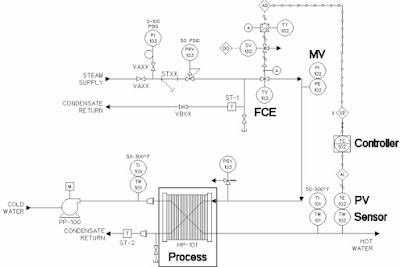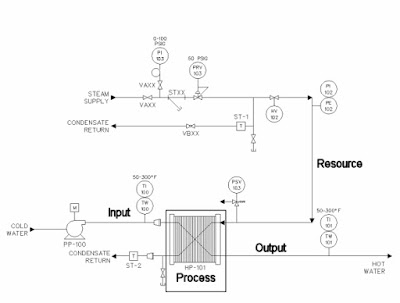PRINCIPLES OF NUCLEONIC GAUGES:
A nucleonic gauge consists of a suitable source (or a number of sources) of alpha, beta, gamma, neutron or X ray radiation arranged in a fixed geometrical relationship with one or more radiation detectors. Most of nucleonic gauges are based on a few most common nuclear techniques.
Natural gamma-ray technique
NCS based on natural gamma-ray technique utilize the correlation between natural gamma-ray intensity measured in one or more pre-selected energy windows and the concentration of particular elements (e.g. U, Th, K) or the value of a given parameter of interest (e.g. ash in coal).
Transmission:
In the basic configuration of a transmission gauge the media to be measured is placed between the radioactive source and the detector so that the radiation beam can be transmitted through it (Fig.1). The media attenuates the emitted radiation (beta particles or photons) before reaching the sensible volume of the detector. Both source and detector can be collimated. The radiation intensity in the detector is a function of several parameter characteristics of the material.
Dual energy gamma-ray transmission (DUET):
This technique is probably the most common nucleonic method for on-the-belt determination of ash content in coal. Ash content is determined by measuring the transmission through coal of narrow beams of low and high-energy gamma rays (Fig. 2). The absorption of the lower energy gamma rays depends on ash content, due to its higher average atomic number than that of coal matter, and on the mass per unit area of coal. The absorption of the higher energy gamma rays depends almost entirely on the mass per unit area of coal in the beam. Ash content is determined by combining measurements of the two beams. The determination is independent of both the bed thickness and the mass of the coal. The technique is also applicable to the analysis of complex fluid flow where multiple energy beams are usefully applied.
Backscattering:
Whenever a radiation beam interacts with matter a fraction of it is transmitted, a fraction absorbed and a fraction is scattered from its original path (Fig. 3). If the scattering angle is greater than 90o some photons or particles will come back towards the original emission point; the measurement of this radiation is the basis of the backscattering method.
Gamma-ray backscatter:
Measurement of radiation emitted by a stationary gamma-ray source placed in the nucleonic gauge and back-scattered from atoms of investigated matter enables some properties of this matter to be determined. The gamma-rays interact with atomic electrons resulting in scattering and absorption. Some of these gamma-rays emerge back from the investigated mater with degraded energy and intensity (count rate) characterizing the bulk density and the average chemical composition of the matter.
Neutron scattering (moderating):
Fast neutrons of high energies emitted from the neutron source collide with nuclei of investigated matter reducing their energy. In general, neutrons lose more energy on collision with light nuclei than with heavy nuclei. Due to its light nucleus hydrogen is most effective in moderating neutrons from the source. As hydrogen is major constituent of most liquids detection of the liquid through container walls is possible, as well as measurement of the moisture (hydrogen density) of soils, coke or other materials.
Prompt gamma neutron activation analysis (PGNAA) and Delayed gamma neutron activation analysis (DGNAA):
When a material is bombarded with neutrons, interactions with nuclei result in the emission of high-energy gamma - rays, at a variety of energy levels. The nuclear reactions excite gamma-rays of energies specific to the target nucleus and the type of nuclear reaction. If the intensity and energy of these are
measured by means of a suitable spectrometric detector, the type and amount of an element present can be determined. The gamma-rays emitted may be classed as prompt, occurring within 10-12 seconds of the interaction, or delayed, arising from the decay of the induced radioactivity. (Fig. 4) The former gamma-rays are utilized in Prompt Gamma Neutron Activation Analysis (PGNAA) and the latter in Delayed Gamma Neutron Activation Analysis (DGNAA). The same probe can be used for both PGNAA and DGNAA elemental analysis (Fig. 5).
A nucleonic gauge consists of a suitable source (or a number of sources) of alpha, beta, gamma, neutron or X ray radiation arranged in a fixed geometrical relationship with one or more radiation detectors. Most of nucleonic gauges are based on a few most common nuclear techniques.
Natural gamma-ray technique
NCS based on natural gamma-ray technique utilize the correlation between natural gamma-ray intensity measured in one or more pre-selected energy windows and the concentration of particular elements (e.g. U, Th, K) or the value of a given parameter of interest (e.g. ash in coal).
Transmission:
In the basic configuration of a transmission gauge the media to be measured is placed between the radioactive source and the detector so that the radiation beam can be transmitted through it (Fig.1). The media attenuates the emitted radiation (beta particles or photons) before reaching the sensible volume of the detector. Both source and detector can be collimated. The radiation intensity in the detector is a function of several parameter characteristics of the material.
FIG. 1. Principle of transmission method.
Dual energy gamma-ray transmission (DUET):
This technique is probably the most common nucleonic method for on-the-belt determination of ash content in coal. Ash content is determined by measuring the transmission through coal of narrow beams of low and high-energy gamma rays (Fig. 2). The absorption of the lower energy gamma rays depends on ash content, due to its higher average atomic number than that of coal matter, and on the mass per unit area of coal. The absorption of the higher energy gamma rays depends almost entirely on the mass per unit area of coal in the beam. Ash content is determined by combining measurements of the two beams. The determination is independent of both the bed thickness and the mass of the coal. The technique is also applicable to the analysis of complex fluid flow where multiple energy beams are usefully applied.
FIG. 2. Dual energy gamma ray transmission for on line measurement of coal ash concentration.
Backscattering:
Whenever a radiation beam interacts with matter a fraction of it is transmitted, a fraction absorbed and a fraction is scattered from its original path (Fig. 3). If the scattering angle is greater than 90o some photons or particles will come back towards the original emission point; the measurement of this radiation is the basis of the backscattering method.
FIG. 3. Principle of backscatter method.
Gamma-ray backscatter:
Measurement of radiation emitted by a stationary gamma-ray source placed in the nucleonic gauge and back-scattered from atoms of investigated matter enables some properties of this matter to be determined. The gamma-rays interact with atomic electrons resulting in scattering and absorption. Some of these gamma-rays emerge back from the investigated mater with degraded energy and intensity (count rate) characterizing the bulk density and the average chemical composition of the matter.
Neutron scattering (moderating):
Fast neutrons of high energies emitted from the neutron source collide with nuclei of investigated matter reducing their energy. In general, neutrons lose more energy on collision with light nuclei than with heavy nuclei. Due to its light nucleus hydrogen is most effective in moderating neutrons from the source. As hydrogen is major constituent of most liquids detection of the liquid through container walls is possible, as well as measurement of the moisture (hydrogen density) of soils, coke or other materials.
Prompt gamma neutron activation analysis (PGNAA) and Delayed gamma neutron activation analysis (DGNAA):
When a material is bombarded with neutrons, interactions with nuclei result in the emission of high-energy gamma - rays, at a variety of energy levels. The nuclear reactions excite gamma-rays of energies specific to the target nucleus and the type of nuclear reaction. If the intensity and energy of these are
measured by means of a suitable spectrometric detector, the type and amount of an element present can be determined. The gamma-rays emitted may be classed as prompt, occurring within 10-12 seconds of the interaction, or delayed, arising from the decay of the induced radioactivity. (Fig. 4) The former gamma-rays are utilized in Prompt Gamma Neutron Activation Analysis (PGNAA) and the latter in Delayed Gamma Neutron Activation Analysis (DGNAA). The same probe can be used for both PGNAA and DGNAA elemental analysis (Fig. 5).
FIG. 4. Principle of PGNNA and DGNAA methods





























